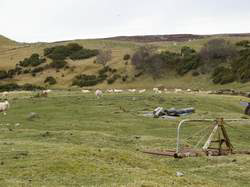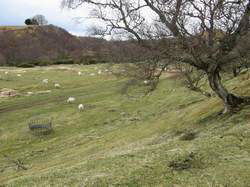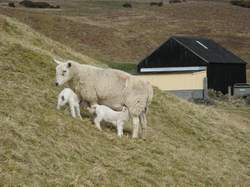Abandoned Communities ..... Strathnaver
Next May, on the Sunday before the evacuations were due to start, Donald Sage preached his last sermon, in the open air in a grassy clearing in Langdale. He described in his Memorabilia that he had difficulty restraining his feelings. Before he came to the end of the sermon he and the congregation broke into weeping.
This part of Donald Sage's Memorabilia can be read at this address.
One of those present on the “last Sabbath” was a child, Annie MacKay. Many years later she wrote a poem about the day. Her poem is in the Poetry section at this address.
For reasons that are unknown Donald Sage was not present during the evacuations. However, he returned to Strathnaver during the following week, when he discovered: "Of all the houses the thatched roofs were gone, but the walls, built of alternate layers of turf and stone remained. The flames of the preceding week still slumbered in their ruins and sent up into the air spiral columns of smoke; whilst here a gable and there a long side-wall might be seen tumbling to the ground from which a cloud of smoke, and then a dusty flame, slowly sprang up."
What had happened was that a large party of officers, constables, shepherds and others had moved systematically through the valley. They started at the western end of Loch Naver, Grummore being the first village to be cleared. Messengers were sent ahead to warn inhabitants to move out within an hour. All buildings, including barns and cowsheds were set on fire. The suffering of several individuals have been recorded. Robert MacKay, for example, whose whole family was sick, carried his two daughters on his back for twenty five miles. He would carry one for some distance, lay her on the grass, then return to collect the other.
The stonemason, Donald MacLeod, was again present to record his observations, which he summarised as "Nothing but the sword was wanting to make the scene one of as great barbarity as the earth ever witnessed." As he recalled: "The consternation and confusion were extreme. Little or no time was given for the removal of persons or property; the people striving to remove the sick and the helpless before the fire should reach them; next, struggling to save the most valuable of their effects. The cries of the women and children, the roaring of the affrighted cattle, hunted at the same time by the yelling dogs of the shepherds amid the smoke and fire, altogether presented a scene that completely baffles description."
At eleven o'clock on the first night MacLeod climbed to a high point from where he could look back ten miles along Loch Naver and see the villages burning. He reckoned there were two hundred and fifty buildings alight.
Many of the evacuees had walked to Bettyhill on the coast, and some were offered a chance to go aboard a small ship bound for Caithness. According to MacLeod twenty families took up the offer, "filling deck, hold, and every part of the vessel." Wind conditions meant that it took nine days to reach Caithness, and "All this time the poor creatures, almost without necessities, most of them dying with sickness, were either wallowing among the lime and various excrements in the hold, or lying on deck exposed to the raging elements."
Where else did people go to? Eric Richards has quoted statistics gathered by the Sutherland estate about the destinations of both tenants and "sub-tenants and persons paying no rent". The statistics refer to all people removed from their homes in 1819 from various parts of the Sutherland estate, but they include those evicted from Strathnaver. Among rent paying tenants 68% were resettled elsewhere on the estate, most of them presumably on the coast, 7% went to neighbouring estates, 21% to adjacent counties, and 2% emigrated. 2% were unaccounted for. Among those who were not tenants the equivalent figures were 73%, 7%, 13%, and 5%, with again 2% not accounted for.
It is likely that a high proportion of people made more than one move. Life for many in the crofting communities on the coast or having a marginal status as refugees on neighbouring estates would have been precarious. Hence the numbers eventually moving south to the Lowlands or cities of Scotland, or into England, or joining the waves of emigration overseas, would have been considerably greater than the 1819 statistics reflect.
Occasionally former residents would return to visit Strathnaver. One woman evicted in 1819 went back a year later. She reported that some of the timbers from her church had been used in the construction of a new inn at Altnaharra, the church yard was full of sheep, Rev Donald Sage's study had become a kennel for Robert Gunn's dogs, and there was a crow's nest in the chimney head of the house that used to belong to James Gordon.
This part of Donald Sage's Memorabilia can be read at this address.
One of those present on the “last Sabbath” was a child, Annie MacKay. Many years later she wrote a poem about the day. Her poem is in the Poetry section at this address.
For reasons that are unknown Donald Sage was not present during the evacuations. However, he returned to Strathnaver during the following week, when he discovered: "Of all the houses the thatched roofs were gone, but the walls, built of alternate layers of turf and stone remained. The flames of the preceding week still slumbered in their ruins and sent up into the air spiral columns of smoke; whilst here a gable and there a long side-
What had happened was that a large party of officers, constables, shepherds and others had moved systematically through the valley. They started at the western end of Loch Naver, Grummore being the first village to be cleared. Messengers were sent ahead to warn inhabitants to move out within an hour. All buildings, including barns and cowsheds were set on fire. The suffering of several individuals have been recorded. Robert MacKay, for example, whose whole family was sick, carried his two daughters on his back for twenty five miles. He would carry one for some distance, lay her on the grass, then return to collect the other.
The stonemason, Donald MacLeod, was again present to record his observations, which he summarised as "Nothing but the sword was wanting to make the scene one of as great barbarity as the earth ever witnessed." As he recalled: "The consternation and confusion were extreme. Little or no time was given for the removal of persons or property; the people striving to remove the sick and the helpless before the fire should reach them; next, struggling to save the most valuable of their effects. The cries of the women and children, the roaring of the affrighted cattle, hunted at the same time by the yelling dogs of the shepherds amid the smoke and fire, altogether presented a scene that completely baffles description."
At eleven o'clock on the first night MacLeod climbed to a high point from where he could look back ten miles along Loch Naver and see the villages burning. He reckoned there were two hundred and fifty buildings alight.
Many of the evacuees had walked to Bettyhill on the coast, and some were offered a chance to go aboard a small ship bound for Caithness. According to MacLeod twenty families took up the offer, "filling deck, hold, and every part of the vessel." Wind conditions meant that it took nine days to reach Caithness, and "All this time the poor creatures, almost without necessities, most of them dying with sickness, were either wallowing among the lime and various excrements in the hold, or lying on deck exposed to the raging elements."
Where else did people go to? Eric Richards has quoted statistics gathered by the Sutherland estate about the destinations of both tenants and "sub-
It is likely that a high proportion of people made more than one move. Life for many in the crofting communities on the coast or having a marginal status as refugees on neighbouring estates would have been precarious. Hence the numbers eventually moving south to the Lowlands or cities of Scotland, or into England, or joining the waves of emigration overseas, would have been considerably greater than the 1819 statistics reflect.
Occasionally former residents would return to visit Strathnaver. One woman evicted in 1819 went back a year later. She reported that some of the timbers from her church had been used in the construction of a new inn at Altnaharra, the church yard was full of sheep, Rev Donald Sage's study had become a kennel for Robert Gunn's dogs, and there was a crow's nest in the chimney head of the house that used to belong to James Gordon.
Five
Eviction notices were distributed during October 1818. To ensure that no one could remain unaware of their contents they were delivered, as described by Donald Sage, to "every house and hovel alike." Rev Donald Sage had recently come to Strathnaver as a minister. He seems to have sympathised with the plight of the local people, but apparently believing that evacuation was inevitable encouraged them to resign themselves to having to move.
The grassy clearing at Langdale where the meeting was held on the last Sabbath
Another view of the grassy clearing, seen from above
The site of the village of Langdale
Langdale, Spring 2008



